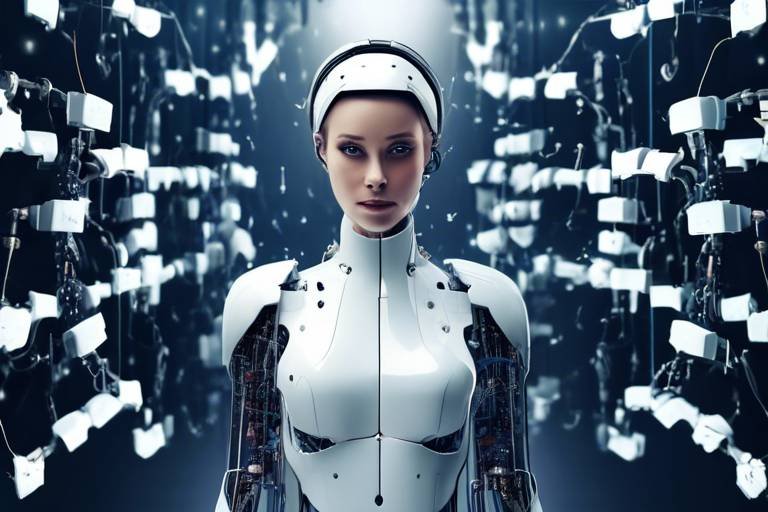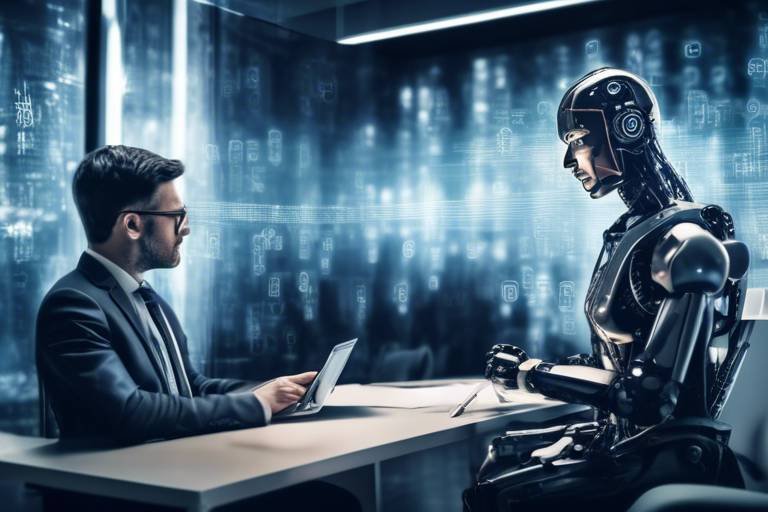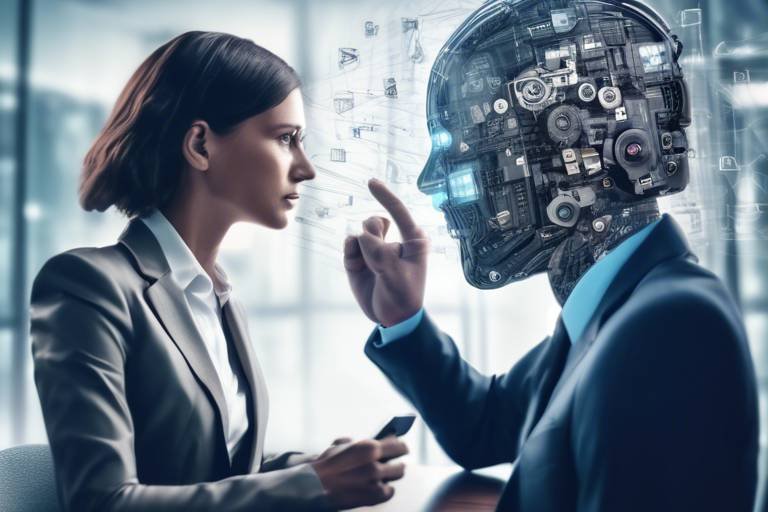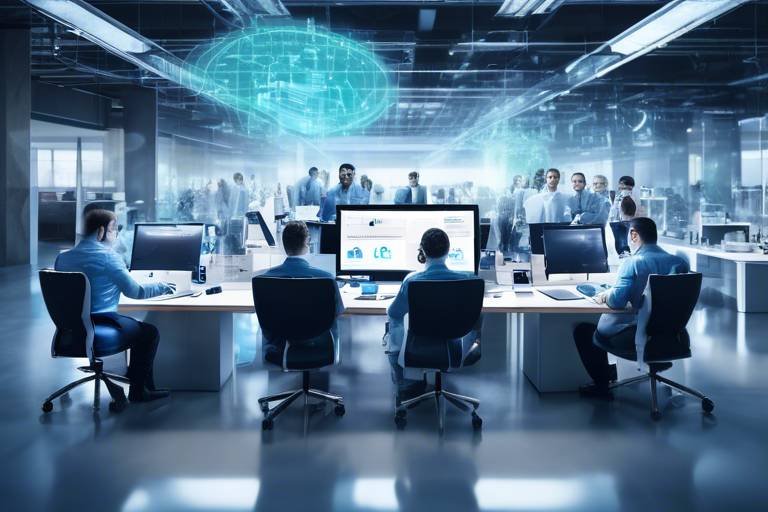AI and Automation: The New Normal of Work
In today's fast-paced world, the integration of AI and automation into the workplace has become more than just a trend; it’s a revolution that is reshaping how we work. Imagine waking up to a world where machines handle repetitive tasks, allowing you to focus on what truly matters. This transformation is not just about replacing manual labor; it’s about enhancing productivity, creativity, and innovation across various sectors. As we dive into this topic, let’s explore how AI and automation are not only changing job roles but also creating new opportunities and challenges for both employees and employers.
AI technologies are advancing at an unprecedented pace, and their integration into various industries is nothing short of remarkable. From healthcare to finance, AI is revolutionizing workflows, making them more efficient and effective. For instance, in the healthcare sector, AI algorithms can analyze medical data and assist doctors in diagnosing diseases faster than ever before. In finance, AI-driven analytics tools can predict market trends, helping businesses make informed decisions. This growing presence of AI is not just a passing phase; it’s a fundamental shift in how we approach work. As we witness this evolution, it’s essential to understand the implications it has on job roles and the skills required to thrive in this new landscape.
With the rise of AI and automation, job descriptions and responsibilities are undergoing significant changes. Many traditional roles are being redefined, and new skills are becoming essential for the future workforce. For example, tasks that were once performed manually are now being automated, leading to a demand for workers who can manage and interpret the data generated by these systems. As we navigate this transformation, it’s crucial to recognize which skills are becoming increasingly valuable. Skills such as data analysis, programming, and digital literacy are now at the forefront of job requirements.
While it’s true that some jobs may be lost to automation, it’s equally important to highlight the new positions that are emerging in the AI-driven economy. The landscape of employment is evolving, and with it comes a plethora of opportunities. For instance, roles such as AI trainers, data scientists, and robotics engineers are gaining traction. These positions require a unique blend of technical expertise and creativity, showcasing the need for a workforce that is adaptable and forward-thinking.
The demand for tech-savvy professionals is skyrocketing as AI becomes more prevalent in the workplace. Companies are actively seeking individuals who can navigate complex software systems, develop AI algorithms, and maintain automated processes. According to recent studies, the following tech-related careers are on the rise:
| Career | Average Salary | Job Growth Rate |
|---|---|---|
| Data Scientist | $120,000 | 31% (2020-2030) |
| AI Engineer | $115,000 | 22% (2020-2030) |
| Robotics Technician | $65,000 | 10% (2020-2030) |
Despite the rise of automation, the importance of human creativity cannot be overstated. Roles that require emotional intelligence, creativity, and critical thinking are more vital than ever. For instance, positions in marketing, design, and human resources rely heavily on interpersonal skills and innovative thinking. In an automated environment, these roles provide a unique balance, ensuring that technology complements human capabilities rather than replacing them.
As the job landscape continues to evolve, it’s imperative for employees to engage in continuous learning. Reskilling and upskilling are no longer optional; they are essential for career advancement in an automated world. Organizations are recognizing the need to invest in their workforce by providing training programs that equip employees with the skills necessary to thrive in an AI-driven environment. This commitment to learning fosters a culture of adaptability and resilience, preparing both individuals and companies for future challenges.
While AI presents numerous benefits, it also poses significant challenges that cannot be overlooked. The integration of AI into the workplace raises ethical concerns, such as privacy issues, bias in decision-making, and the potential for job displacement. It’s crucial for businesses to address these challenges proactively to ensure a smooth transition into this new era of work.
The implementation of AI raises ethical questions that demand careful consideration. For instance, how do we ensure that AI systems are free from bias? What measures can be taken to protect employee privacy? These questions highlight the importance of establishing ethical guidelines and frameworks that govern the use of AI in professional settings. Organizations must prioritize transparency and accountability to build trust with their workforce.
As automation increases, certain jobs may become obsolete, leading to broader economic implications. It’s essential for industries and workers to adapt to these changes by embracing new opportunities and pursuing lifelong learning. By fostering a culture of innovation and adaptability, we can mitigate the adverse effects of job displacement and create a more resilient workforce.
- What jobs are most at risk due to automation? Jobs that involve repetitive tasks, such as assembly line work and data entry, are at higher risk of being automated.
- How can I prepare for a career in an AI-driven workplace? Focus on developing skills in data analysis, programming, and emotional intelligence to stay relevant in the job market.
- Are there any benefits to automation? Yes, automation can enhance productivity, reduce human error, and free up time for employees to focus on more creative tasks.

The Rise of AI in the Workplace
As we step into an era dominated by rapid technological advancements, Artificial Intelligence (AI) is no longer just a buzzword; it’s a transformative force reshaping the very fabric of our workplaces. Imagine walking into an office where mundane tasks are handled by intelligent systems, freeing up valuable time for employees to focus on creative and strategic initiatives. This is not a distant dream but a reality that many businesses are embracing today. From manufacturing to finance, AI is revolutionizing workflows and enhancing efficiency, allowing companies to operate at unprecedented levels of productivity.
The integration of AI technologies across various sectors is akin to adding a turbocharger to a car; it boosts performance and accelerates growth. For instance, in the healthcare industry, AI algorithms are being utilized to analyze patient data, predict outcomes, and even assist in surgeries. Similarly, in retail, AI-driven analytics help businesses understand consumer behavior, optimize inventory, and personalize customer experiences. This growing presence of AI is not just a trend; it’s a fundamental shift in how work is done.
However, with great power comes great responsibility. As AI systems become more prevalent, companies must navigate the complexities of implementation. They need to ensure that their AI tools are not only effective but also ethical and inclusive. This involves training AI to recognize and mitigate biases, ensuring that decisions made by these systems are fair and just. The challenge lies in balancing the benefits of automation with the need for human oversight, creating a harmonious relationship between man and machine.
To illustrate the widespread impact of AI in the workplace, consider the following table that highlights some key industries and their AI applications:
| Industry | AI Applications |
|---|---|
| Healthcare | Predictive analytics, robotic surgeries, patient management |
| Finance | Fraud detection, algorithmic trading, risk assessment |
| Manufacturing | Predictive maintenance, quality control, supply chain optimization |
| Retail | Customer personalization, inventory management, sales forecasting |
As we can see, AI is not confined to a single sector; it is a versatile tool that can enhance various aspects of business operations. The question arises: how do employees fit into this evolving landscape? Will they be rendered obsolete, or will they find new roles in an AI-enhanced workplace? The answer lies in understanding that while AI can automate tasks, it cannot replicate the unique human qualities of creativity, empathy, and critical thinking. Therefore, the rise of AI presents an opportunity for workers to evolve alongside technology, adapting to new roles that leverage their uniquely human skills.
In conclusion, the rise of AI in the workplace is a double-edged sword. While it offers remarkable opportunities for efficiency and innovation, it also requires a thoughtful approach to integration. Companies must invest in training and reskilling their workforce, ensuring that employees are equipped to thrive in this new environment. As we embrace this technological revolution, it’s crucial to remember that AI should be seen as a partner in productivity, not a replacement for the human touch.

The Impact on Job Roles
As we dive into the heart of the matter, it's clear that the integration of AI and automation is not just a passing trend; it's a seismic shift in how we perceive work. Imagine walking into your office tomorrow and finding that your role has morphed into something entirely different, or that your daily tasks are now managed by a sophisticated algorithm. Sounds a bit sci-fi, right? But this is the reality many employees are facing today. The way we work is evolving, and so are the job descriptions that come with it.
AI is not just here to assist; it's reshaping the very fabric of job roles across various industries. For instance, traditional roles in data entry and routine analysis are increasingly being replaced by intelligent systems that can process information faster and more accurately than any human. This shift means that employees must adapt by acquiring new skills that align with the technological advancements. Consider this: if your job was once about managing spreadsheets, it’s now about interpreting the data that those spreadsheets generate. This transition requires a blend of analytical skills and technological know-how.
Moreover, the demand for soft skills is skyrocketing. As machines take over repetitive tasks, employers are now on the lookout for individuals who can bring creativity, emotional intelligence, and problem-solving abilities to the table. In this new landscape, roles that focus on human interaction and innovative thinking are becoming more valuable. For example, a marketing professional might find that their role has shifted from merely executing campaigns to creating compelling narratives that resonate with audiences, leveraging insights generated by AI tools.
To illustrate the shifting landscape, let’s take a look at a table comparing traditional job roles with their evolving counterparts in the age of AI:
| Traditional Role | Evolving Role | Skills Required |
|---|---|---|
| Data Entry Clerk | Data Analyst | Analytical Thinking, Data Visualization |
| Customer Service Representative | Customer Experience Manager | Emotional Intelligence, Problem Solving |
| Marketing Coordinator | Marketing Strategist | Creativity, Strategic Thinking |
As we can see, the evolution of job roles is not just about losing jobs to machines; it’s about transforming how we work and what is expected of us. The future workforce will need to be agile, ready to pivot into new areas as technology advances. This constant evolution means that lifelong learning will become a key component of career success. Employees will need to embrace a mindset of reskilling and upskilling, continually updating their knowledge and abilities to stay relevant in their fields.
But what does this mean for you? If you're currently in a role that feels threatened by automation, don’t panic! This is an opportunity to expand your skill set and pivot into a role that leverages your unique human abilities. Think of it as a chance to reinvent yourself, much like a caterpillar transforming into a butterfly. The key is to stay informed about industry trends and invest in your personal development.
In conclusion, the impact of AI on job roles is profound. It’s not merely about job displacement; it's about the evolution of work itself. As we embrace this new normal, let’s focus on the opportunities that come with it. After all, change is the only constant in life, and adapting to that change is what will set us apart in the workforce of the future.

Emerging Job Opportunities
As we navigate through the waves of technological advancement, it’s fascinating to see how the landscape of job opportunities is evolving. While the fear of job loss due to automation is palpable, it’s essential to recognize that with every challenge comes a new horizon of possibilities. The AI-driven economy is not just about replacing old roles; it’s about creating new ones that we may not have even imagined a few years ago. Think of it as a garden where, although some plants may wilt, new flowers bloom, bringing vibrant colors and fragrances that enrich our environment.
In this brave new world, several sectors are witnessing a surge in demand for talent. For instance, fields like data analysis and machine learning are becoming increasingly important. Companies are on the lookout for professionals who can interpret data and extract valuable insights to drive decision-making. This isn’t just a trend; it’s a fundamental shift in how businesses operate. As a result, job roles such as data scientists and AI specialists are not only emerging but are also becoming some of the most sought-after positions in the job market.
Moreover, the rise of automation has led to an increased need for cybersecurity experts. With more businesses relying on AI systems, the risk of cyber threats escalates. Organizations are scrambling to protect their data and systems, thus creating a lucrative avenue for those skilled in cybersecurity. Additionally, the healthcare sector is experiencing a transformation, where roles like health informatics specialists and telehealth coordinators are gaining traction. These positions leverage technology to improve patient care and streamline processes, showcasing how AI can enhance human roles rather than replace them.
But it’s not just the tech-savvy roles that are on the rise. The importance of human-centric roles cannot be overstated. As AI takes over repetitive tasks, the demand for positions requiring emotional intelligence and creativity is soaring. For example, roles in customer experience management and creative design are thriving. These positions rely on human insight, empathy, and creativity—qualities that machines cannot replicate. In a world increasingly dominated by technology, the human touch remains irreplaceable.
To further illustrate this evolution, let’s consider a table that summarizes some of the emerging job opportunities:
| Job Role | Industry | Key Skills Required |
|---|---|---|
| Data Scientist | Technology | Statistical analysis, programming, machine learning |
| Cybersecurity Expert | Information Technology | Network security, risk assessment, incident response |
| Health Informatics Specialist | Healthcare | Data management, health information systems, patient care |
| Customer Experience Manager | Retail/Services | Communication, empathy, problem-solving |
In conclusion, while the fear of job displacement is valid, it’s crucial to focus on the emerging opportunities that AI and automation bring. The job market is not disappearing; it’s evolving. By embracing change and investing in skills that align with this new landscape, individuals can position themselves for success in a world where technology and humanity coexist harmoniously. So, are you ready to explore these exciting new paths?

Tech-Related Careers
As we dive deeper into the realm of AI and automation, a fascinating transformation is taking place in the job market. The demand for tech-related careers is surging, and this isn't just a passing trend; it's becoming a crucial part of our professional landscape. Imagine a world where every industry—from healthcare to finance—is powered by advanced algorithms and intelligent machines. In this environment, tech-savvy professionals are no longer just an asset; they are the backbone of innovation and efficiency.
So, what exactly does this mean for aspiring workers? Well, it opens up a plethora of opportunities for individuals who are willing to adapt and learn. Roles such as data scientists, machine learning engineers, and AI specialists are becoming increasingly prevalent. These positions require a unique blend of technical skills and creative problem-solving abilities. For instance, a data scientist not only needs to be proficient in programming languages like Python and R but also must possess a knack for interpreting complex data sets and translating them into actionable insights.
Moreover, as companies strive to integrate AI into their operations, they also require professionals who can manage and maintain these systems. This has led to a rise in demand for roles such as AI project managers and cloud computing specialists. These individuals play a pivotal role in ensuring that AI initiatives align with business goals and deliver tangible results. It's akin to being a conductor of an orchestra, where each musician (or machine) plays a vital part in creating a harmonious performance.
To further illustrate the variety of tech-related careers, let’s take a closer look at some specific roles gaining traction:
| Job Title | Description | Skills Required |
|---|---|---|
| Data Scientist | Analyzes complex data to help organizations make informed decisions. | Statistics, Programming, Data Visualization |
| Machine Learning Engineer | Develops algorithms that enable machines to learn from data. | Python, R, TensorFlow |
| AI Project Manager | Oversees AI projects to ensure they meet objectives and deadlines. | Project Management, Communication, Technical Knowledge |
| Cloud Computing Specialist | Manages cloud infrastructure and services to support AI applications. | Cloud Platforms (AWS, Azure), Networking, Security |
In addition to these roles, the tech sector is also witnessing a rise in positions that blend technology with creativity. For example, UX/UI designers are crucial in ensuring that AI applications are user-friendly and intuitive. They focus on the human experience, bridging the gap between technology and the end-user. This highlights an essential truth: while technology advances, the human touch remains irreplaceable.
In summary, the landscape of tech-related careers is expanding rapidly as AI and automation continue to reshape our workplaces. The key takeaway here is that those who embrace this change and invest in their skills will find themselves at the forefront of a new era in employment. So, whether you're a seasoned professional or a newcomer to the job market, now is the perfect time to explore the exciting opportunities that lie ahead in the tech world.
- What skills are most important for tech-related careers? Skills in programming, data analysis, and project management are essential, along with a willingness to learn continuously.
- Are tech-related careers only for people with a background in computer science? Not necessarily! Many roles value diverse skills and experiences, and there are many resources available for learning.
- How can I transition into a tech-related career? Consider taking online courses, attending workshops, or even pursuing certifications in areas of interest.

Creative and Human-Centric Roles
In a world increasingly dominated by automation and artificial intelligence, one might wonder: what happens to the jobs that require a human touch? The truth is, while machines are taking over repetitive tasks and data analysis, the demand for is not just surviving; it's thriving! These roles leverage the unique qualities that only humans possess, such as empathy, creativity, and emotional intelligence. Think of it this way: while AI can churn out reports and analyze trends faster than any human, it lacks the ability to connect with people on a personal level or to create art that resonates with the soul.
Creative roles, for instance, span a wide range of industries—from marketing and advertising to design and entertainment. In these fields, individuals are needed to craft compelling narratives, design visually stunning graphics, and develop innovative campaigns that capture the essence of human experience. It's this blend of creativity and emotional engagement that machines simply can't replicate. For example, a talented copywriter can weave words into stories that evoke emotions, while an AI might only produce content based on algorithms and data.
Moreover, human-centric roles that focus on interpersonal skills are becoming increasingly vital. Professions in healthcare, education, and social services rely heavily on the ability to understand and respond to human emotions. Nurses, teachers, and counselors, for example, require a level of empathy and connection that AI cannot provide. These roles not only enrich the lives of those they serve but also contribute to a sense of community and belonging—something that is essential in our fast-paced, technology-driven world.
As we look towards the future, it's clear that the integration of AI will not eliminate the need for these creative and human-centric roles; rather, it will enhance them. For instance, consider how AI can assist a graphic designer by providing data-driven insights into current trends, allowing the designer to focus on the creative aspects of their work. This collaboration between humans and machines can lead to innovative solutions that neither could achieve alone.
In conclusion, while AI and automation may redefine many job roles, the importance of creativity and human connection remains irreplaceable. As we embrace this new era of work, it's crucial to recognize that the most successful organizations will be those that foster a balance between technological advancements and the irreplaceable qualities that make us human. By investing in the development of creative and human-centric roles, we can ensure a future where technology and humanity coexist harmoniously.
- What are creative and human-centric roles?
These are job positions that require creativity, emotional intelligence, and interpersonal skills, often found in fields such as marketing, healthcare, and education. - Will AI replace creative jobs?
While AI can assist in creative processes, it cannot fully replace the emotional and creative aspects that humans bring to these roles. - How can I prepare for a career in a creative role?
Focus on developing soft skills like communication and empathy, and enhance your creative abilities through practice and learning.

Reskilling and Upskilling
In today's rapidly evolving job market, the concepts of reskilling and upskilling have become essential for employees who want to stay relevant and competitive. With automation and artificial intelligence transforming the workplace, it's no longer enough to rely on the skills you acquired in school or your previous job. Instead, continuous learning has emerged as a vital strategy for career advancement and job security.
But what exactly do these terms mean? Reskilling refers to the process of learning new skills to perform a different job or role, while upskilling involves enhancing existing skills to improve performance in your current position. Both approaches are crucial in an era where job descriptions are constantly changing, often overnight. Imagine trying to navigate a new city without a map; that’s what it feels like for many workers today without the right skills to adapt to new technologies.
As companies increasingly adopt AI-driven tools, they are seeking employees who not only understand these technologies but can also leverage them to improve productivity and innovation. This shift means that workers must actively engage in their own learning journeys. Here are some key areas where reskilling and upskilling are particularly important:
- Technical Skills: Familiarity with AI tools, data analysis, and programming languages is becoming essential in many fields.
- Soft Skills: Skills such as communication, teamwork, and emotional intelligence are increasingly valued, especially in roles that require human interaction.
- Industry-Specific Knowledge: Understanding the nuances of your industry can set you apart from the competition.
To facilitate this ongoing learning, many organizations are investing in training programs and partnerships with educational institutions. For example, companies might offer workshops, online courses, or even financial assistance for employees pursuing further education. This not only helps employees grow but also benefits employers by creating a more skilled and adaptable workforce.
Moreover, the rise of online learning platforms has made it easier than ever for individuals to access high-quality educational resources. Platforms like Coursera, Udacity, and LinkedIn Learning offer a plethora of courses tailored to various skill levels and interests. This democratization of education means that anyone with a desire to learn can find the resources they need to succeed.
It's also worth noting that the responsibility for reskilling and upskilling isn't solely on the employees. Employers play a crucial role in fostering a culture of learning. By encouraging continuous education and providing the necessary tools and resources, companies can help their workforce thrive in this new landscape. After all, a well-trained employee is an asset that can drive innovation and growth.
In conclusion, as we navigate this new normal of work, the importance of reskilling and upskilling cannot be overstated. Embracing lifelong learning is not just a personal choice; it's a necessity for survival in an increasingly automated world. So, whether you're looking to pivot into a new career or simply enhance your current skill set, remember that the journey of learning is ongoing. The future belongs to those who are willing to adapt and grow.
Q: What is the difference between reskilling and upskilling?
A: Reskilling involves learning new skills for a different job, while upskilling focuses on enhancing existing skills for your current role.
Q: How can I start reskilling or upskilling?
A: You can begin by identifying the skills that are in demand in your industry and seeking out courses or training programs that align with those needs.
Q: Are there any financial resources available for training?
A: Many companies offer tuition reimbursement or training budgets, and there are also scholarships and grants available for specific courses or certifications.
Q: How important are soft skills in the age of AI?
A: Soft skills like communication, teamwork, and emotional intelligence are increasingly important, as they complement technical skills and enhance collaboration in the workplace.

Challenges of AI Integration
As we dive deeper into the world of artificial intelligence (AI), it’s essential to acknowledge that with great power comes great responsibility. While AI integration into the workplace is undeniably revolutionary, it also brings forth a series of challenges that both employers and employees must navigate. The excitement surrounding AI often overshadows the potential pitfalls, but understanding these challenges is crucial for a balanced approach to this transformation.
One of the primary concerns is the issue of job displacement. As AI systems become more capable of performing tasks traditionally handled by humans, there is a genuine fear that many jobs will become obsolete. For instance, roles in manufacturing, data entry, and even customer service are increasingly being automated. This shift not only affects individuals but also has broader economic implications. Companies must consider how to manage this transition responsibly to avoid a significant workforce upheaval.
Moreover, the integration of AI raises profound ethical considerations. Questions surrounding privacy, bias, and decision-making processes are at the forefront of this discussion. For example, AI algorithms can inadvertently perpetuate biases present in their training data, leading to unfair treatment of certain groups of people. This can have serious repercussions, especially in fields like hiring, lending, and law enforcement. Companies must prioritize ethical AI practices to ensure that their technologies promote fairness and transparency.
In addition to ethical concerns, there’s also the challenge of maintaining human oversight. As AI systems take on more responsibilities, it becomes critical to ensure that human judgment remains a part of the decision-making process. Relying solely on AI can lead to scenarios where decisions are made without considering the human context, which can be detrimental. Striking a balance between automation and human intervention is essential to harness the benefits of AI while mitigating its risks.
Furthermore, the rapid pace of technological advancement means that businesses must constantly adapt. This need for continuous learning can be overwhelming for employees. Organizations must invest in training and development to help their workforce keep pace with new tools and technologies. Without proper support, employees may feel left behind, leading to decreased morale and productivity. It’s vital for companies to foster an environment where reskilling and upskilling are prioritized as part of their corporate culture.
Lastly, the economic impact of AI integration cannot be overlooked. While AI has the potential to drive efficiency and innovation, it also poses risks to economic stability. Industries heavily reliant on manual labor may face significant disruptions, leading to increased unemployment rates in those sectors. To mitigate these impacts, it is crucial for governments and organizations to collaborate on policies that support displaced workers, including retraining programs and social safety nets.
In summary, while AI integration offers a wealth of opportunities, it is accompanied by a set of challenges that must be addressed thoughtfully. From ethical considerations to job displacement and the need for continuous learning, navigating this new terrain requires a concerted effort from all stakeholders involved. By being proactive about these challenges, we can create a future where AI enhances our work lives rather than complicates them.
- What are the main challenges of integrating AI into the workplace?
The main challenges include job displacement, ethical concerns, maintaining human oversight, the need for continuous learning, and economic impacts.
- How can companies address job displacement due to AI?
Companies can address job displacement by investing in retraining and upskilling programs to help employees transition into new roles.
- What ethical considerations should be taken into account with AI?
Ethical considerations include ensuring fairness, transparency, and accountability in AI decision-making processes.
- Why is human oversight important in AI decision-making?
Human oversight is crucial to ensure that decisions made by AI systems consider the human context and ethical implications.

Ethical Considerations
The integration of AI into the workplace is not just a technological shift; it brings with it a host of that must be addressed. As we embrace the capabilities of AI, we also need to be vigilant about the implications it has on our society, workplace dynamics, and individual rights. For instance, the way AI systems are designed can significantly impact issues of privacy and bias. When algorithms are trained on biased data, they can perpetuate and even amplify existing inequalities, leading to unfair treatment of certain groups. Imagine a hiring algorithm that favors candidates from a particular demographic simply because it was trained on historical hiring data that reflects past biases. This scenario raises serious questions about the fairness and transparency of AI-driven decision-making.
Moreover, the use of AI in the workplace can lead to a lack of accountability. When decisions are made by machines, it can be challenging to determine who is responsible when things go wrong. For example, if an AI system makes a hiring decision that results in discrimination, pinpointing the liability can be a complex issue. This uncertainty can create a moral dilemma for organizations that rely heavily on these technologies. Are they willing to accept the risks that come with deploying AI systems without a clear understanding of their implications?
Additionally, the ethical use of AI involves safeguarding employee privacy. With tools that monitor productivity and behavior more closely than ever, employees may feel as though they are constantly under surveillance. This can lead to a workplace environment that stifles creativity and innovation, as individuals may hesitate to express themselves for fear of being misjudged by an algorithm. It's crucial for organizations to strike a balance between leveraging AI for productivity and respecting the autonomy and privacy of their workforce.
To navigate these ethical waters, companies should consider establishing clear guidelines and practices surrounding AI usage. This includes:
- Implementing transparent AI systems that allow for human oversight.
- Regularly auditing algorithms to identify and correct biases.
- Ensuring that employees are informed about how AI is being used in their workplace.
Ultimately, the ethical implications of AI in the workplace are profound and multifaceted. As we continue to integrate these technologies into our daily operations, it is essential to engage in open dialogues about their impact. By doing so, we can ensure that the future of work is not only efficient but also equitable and just for all involved.
Q: What are the main ethical concerns regarding AI in the workplace?
A: The main ethical concerns include privacy issues, bias in decision-making, accountability for AI-driven decisions, and the potential for employee surveillance.
Q: How can companies mitigate the risks associated with AI?
A: Companies can mitigate risks by implementing transparent AI systems, regularly auditing algorithms for bias, and ensuring employee awareness of AI usage.
Q: Why is transparency important in AI systems?
A: Transparency is crucial because it helps build trust among employees and stakeholders, ensuring that AI systems are used fairly and responsibly.

Job Displacement and Economic Impact
The rise of AI and automation is undoubtedly reshaping the landscape of employment. As machines become more capable of performing tasks traditionally handled by humans, the prospect of job displacement looms large. This phenomenon raises critical questions about the future of work and the economic implications that accompany these changes. Many workers find themselves in a precarious position, wondering whether their skills will remain relevant in an increasingly automated world. The reality is that while AI can enhance productivity and efficiency, it also poses significant challenges for the workforce.
One of the most pressing concerns is the potential for widespread job loss. According to a report from the World Economic Forum, it is estimated that by 2025, 85 million jobs may be displaced by the shift towards machines and automation. However, it’s essential to note that this shift does not solely equate to a net loss of employment. In fact, the same report predicts the creation of 97 million new roles that will emerge as a result of this technological evolution. This duality highlights a critical point: while certain jobs may vanish, others will rise from the ashes, leading to a transformation rather than a complete eradication of the job market.
In terms of economic impact, regions that heavily rely on industries susceptible to automation—such as manufacturing and retail—may face significant challenges. These areas could experience rising unemployment rates, leading to increased economic disparity. To illustrate this point, consider the following table that outlines the sectors most at risk of job displacement due to automation:
| Industry | Estimated Job Loss (%) |
|---|---|
| Manufacturing | 50% |
| Retail | 40% |
| Transportation | 30% |
| Administrative Support | 50% |
As we can see, these sectors are particularly vulnerable. However, it’s not all doom and gloom. The emergence of new technologies often creates opportunities for innovation and entrepreneurship. For instance, as traditional roles decline, there is a growing demand for skilled workers in fields such as AI development, data analysis, and cybersecurity. This shift necessitates a proactive approach from both employees and employers to adapt to the evolving job landscape.
Furthermore, the economic impact of job displacement extends beyond individual workers. Communities may struggle to adapt to the rapid changes, leading to social unrest and a widening gap between those who can transition into new roles and those who cannot. To mitigate these effects, it is crucial for governments and organizations to invest in reskilling and upskilling programs that equip workers with the necessary skills to thrive in an automated economy. By fostering a culture of continuous learning, we can empower individuals to navigate the complexities of the job market and reduce the negative economic impact of automation.
In conclusion, while job displacement due to AI and automation presents significant challenges, it also offers opportunities for growth and transformation. By understanding the economic implications and actively engaging in reskilling initiatives, we can work towards a future where humans and machines coexist harmoniously in the workplace.
- Will AI completely replace human jobs?
No, while AI may displace certain jobs, it will also create new opportunities that require human skills. - What industries are most at risk due to automation?
Industries such as manufacturing, retail, and transportation are particularly vulnerable to job displacement. - How can workers prepare for changes in the job market?
Engaging in continuous learning and reskilling can help workers adapt to the evolving job landscape. - What role do governments play in addressing job displacement?
Governments can support reskilling initiatives and create policies that promote workforce development in response to automation.
Frequently Asked Questions
- What is the role of AI in the workplace?
AI is revolutionizing the workplace by enhancing efficiency and productivity. It automates repetitive tasks, allowing employees to focus on more strategic and creative aspects of their jobs. This integration leads to smoother workflows and can significantly reduce operational costs.
- How is automation affecting job roles?
Automation is reshaping job descriptions and responsibilities across various sectors. While some tasks are becoming obsolete, new roles are emerging that require a different skill set, particularly in technology and human-centric fields. Employees must adapt to these changes to stay relevant in the job market.
- Are there new job opportunities arising from AI and automation?
Absolutely! The rise of AI is creating numerous job opportunities, especially in tech-related careers such as data analysis, AI development, and cybersecurity. Moreover, roles that require emotional intelligence and creativity are becoming increasingly valuable, as these skills cannot be easily replicated by machines.
- What does reskilling and upskilling mean in the context of AI?
Reskilling and upskilling refer to the process of learning new skills or enhancing existing ones to keep pace with changing job demands. In an automated world, continuous learning is crucial for career advancement, enabling employees to transition into new roles or adapt to evolving technologies.
- What are some challenges associated with AI integration?
While AI offers many benefits, it also presents challenges such as ethical concerns regarding privacy and bias, as well as the potential for job displacement. Companies must navigate these issues carefully to ensure a fair and responsible implementation of AI technologies.
- How can we address the ethical implications of AI?
Addressing ethical implications requires a proactive approach, including establishing clear guidelines for AI use, ensuring transparency in decision-making processes, and actively working to eliminate biases in AI algorithms. Engaging diverse teams in the development of AI systems can also help mitigate ethical risks.
- What should workers do to prepare for the changes brought by AI?
Workers should embrace a mindset of lifelong learning, seeking opportunities to acquire new skills and knowledge. This can involve taking courses, attending workshops, or gaining practical experience in emerging technologies. Networking with professionals in their field can also provide valuable insights and support.



















